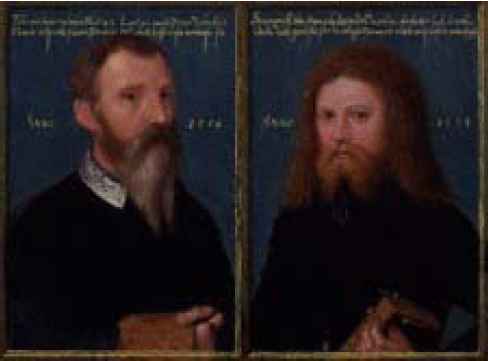Gerlach Flicke, Self-portrait, 1554/5
Nicholas Hilliard, A Treatise concerning the arte of limning (manuscript, c. 1598-1602/3) printed in R. Thornton & T. Cain (ed.s), A Treatise Concerning the Art of Limning by Nicholas Hilliard (Manchester, 1981), pp.67-69:
Nevertheless, if a man be so endued by nature, and live in time of trouble, and under a savage government wherein arts be not esteemed, and himself but of small means, woe be unto him as unto an untimely birth! For of mine own knowledge it hath made poor men poorer, as many among others (many) the most rare English drawer of story works in black and white, John Bossam; one for his skill worthy to have been Serjeant Painter to any king or emperor, whose works in that kind are comparable with the best whatsoever, in cloth, in distemper colours, or black and white. Who being very poor, and belike wanting to buy fair colours, wrought therefore for the most part in black and white; and growing yet poorer by charge of children etc., gave painting clean over; but being a very fair conditioned, zealous and godly person, grew into a love of God’s divine service, upon the liberty of the gospel at the coming in of Queen Elizabeth, and became a reading minister: only unfortunate because he was English born, for even strangers would otherwise have set him up.
We can see from this quote that painting had a low status and was looked down on by most people.
Henry Peacham, The Complete Gentleman (1634) writing about his schooldays in the late 1580s-90s (he was born in 1578), p.126:
Painting is a quality I love.., yet when I was young I have been cruelly beaten by ill and ignorant Schoolmasters… yet could they never beat it out of me. I remember one Master I had… took me one time drawing out with my penne that pear-tree and boyes throwing at it, at the end of the Latine Grammar: which hee perceiving in a rage strooke me with that great end of the rodde, and rent my paper, swearing that it was the only way to teach me to robbe Orchards; beside, that I was placed with him to be made a Scholler and not a Painter…
He is reminiscing about his school days. Note that the ‘pear-tree and boyes’ was an emblem of a type that printers put at the end of books as their trademark. It was obviously considered impossible to be both a scholar and a painter. England was different from France and Germany in the way it regarded painters and its about 100 years behind Italy.
Why was England behind its European neighbours? The lack of patronage of royalty and nobility, the instability caused by the Wars of the Roses. For their thinking at the time consider what George Buck wrote.
Sir George Buck, The Third Universitie ofEngland (1615 edition), p.986:
In the art called of Aristotle ypctqnq (Graphice) and in English painting; There be in this citie cunning masters, for either shaddowing, pourtraying, counterfetting, tricking, painting, enlumining, or limning. But this is an art now not accounted ingenuous or fit for Gentlemen, by reason that it is much fallen from the reputation which it had aunciently which whether it be for the unworthiness or unskilfulnesse of the persons exercising it and practising it in this age, or for the abuses and deceipts used by paynters, ot for the scandall of images and idols (for which Philo condemneth it) or for the foul devise of the faire cosmetica or for what cause I know not well, but sure I am, it is now accounted base and mechanicall, and a mere mestier of an artificer, and handy craftsman. In so much as fewe or no Gentleman or generous and liberall person will adventure the practising this art.
First note that the words used often had a double meaning, an artistic meaning and a negative meaning so it was impossible to talk about painting without being negative. For example, counterfeiting meant painting a portrait but it also had the modern use, tricking was producing a rough sketch, shadowing, cunning. Cunning is used all the time to the extent that it became a clique meaning clever, inventive and good at their job. ‘Mestier’ is a craft.
The reasons given were:
- Painters were incompetent
- Painters used deceits and were abusive
- Images suggested idols which were scandalous
- Women ‘painted’ their faces with cosmetics which was thought to make her a ‘whore’
- Painting is considered a mechanical art fit only for a craftsman
The following is typical of the works of low quality:
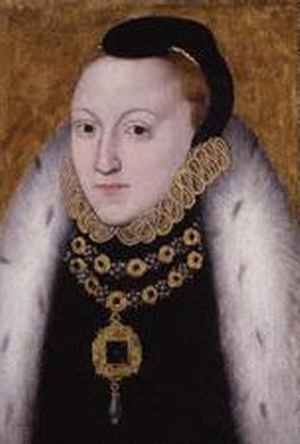
Unknown painter, Elizabeth I (NPG), c. 1560s
The ‘abuses and deceipts’ are probably flattery or over charging or a lack of control or the type of gimmicky anamorphic works like William Scrots below.

William Scrots, Prince Edward (NPG), 1546
Mary married into the Hapsburg empire when she married Philip II of Spain and the family sent over a court painter who produced very high quality work. There was also a Titian in London at the time but it appears to have made no impact and there are no written reviews or comments. High quality painting needs an educated viewer as well as an educated artist.
People were collecting paintings for their long galleries and the number of paintings increased dramatically. Even though they commissioned paintings did they appreciate them as we might or were they simply interested in the subject of the painting which was always a portrait of a king, a famous person and a member of their ancestral family.
The reference to classical appreciation of art was double-sided as in antiquity views were mixed. Plato thought painting was producing shadows of shadows when we should be striving to see reality. Writing in the 1st century AD the Roman writer Seneca looked at their work and said: “One venerates the divine images, one may pray and sacrifice to them, yet one despises the sculptors who made them”.
Buck also refers to the scandal of idolatry. It is interesting that in the time of Henry VIII a public scandal developed after it was shown that a ‘miraculous’ statue of the Virgin Mary was actually a puppet worked by strings and the monks had been deceiving people.
Stephen Bateman, Batman uppon Bartholome (1582), p.394 compares painters of different nationalities:
Frenchmen [are] subtill, and therefore manye times, although theyr workes be far worse then the Englishmans is, they obteine reward when the other goeth without. The Dutchman for imagination and oile hath proved singular, his shift is to be tedious and long, fayning his work, that therby it may seme both chargable and laborius. The Englishman oftentimes marreth all or maketh nothing.
There are not many texts about the visual arts. This one criticises the French and Dutch but also the English.
George Buck criticises the arts as ‘base and mechanical’. This is a reference to the mechanical and liberal arts.
The Liberal and Mechanical Arts.
The 7 liberal arts represented knowledge essential for a gentleman, subdivided into:
the quadrivium: arithmetic, geometry, astronomy, harmonics (music theory) the trivium: grammar, rhetoric, dialectics (logic and philosophical debate).
The 7 mechanical arts stressed physical rather than intellectual labour:
Weaving, making armour, navigation, agriculture, hunting, medicine, living arts or sports.
The ‘living arts’ is a catch all that includes painting and sculpture. These categories go back to the ancient world and were continued through the middle ages. Alberti and Leonardo were trying to raise the status of painting by emphasising the mathematical side (perspective) and the classical references.
George Gower, Self-portrait (Private collection), 1579
This painting shows a balance and in the balance is painting (represented by mathematical dividers used to construct images) weighed against his own family arms.
George Gower (Serjeant Painter to Elizabeth I) in an inscription on his self- portrait (private collection) dated 1579. See catalogue entry in K. Hearn (ed.), Dynasties (Tate, 1995) for further bibliography.
Though yovthfull wayes me did intyse, From armes and uertew e[ke]
yet thanckt be God for his god gift, wch long did rest as slepe
Now skill reuyes wth gayne, and lyfe to leade in rest
by pensils trade, wherfore I must, esteme of it as best
The proof wherof thies balance show, and armes my birth displayes
what Parents bare by just re[n]owne, my skill mayntenes the prayes
And them whose vertew, fame and acts, haue won for me this shield
I reuerence muche wth seruyce eke, and thanks to them do yield.
Note that e[ke] means in addition to or also, ‘uertew’ is ‘virtue’, ‘reuyes’ is ‘revives’, ‘gayne’ is ‘gain’. He is saying he is very proud of his ancestors but he esteems his status as a painter more than his ancestry. A very unusual and unexpected point of view.
What did a Serjeant Painter do?
Grant to Leonard Fryer and John de Critz of the joint office of Serjeant Painter to King James I, dated 11 May 1605 (translated from the Latin in E. Auerbach, Tudor Artists (London, 1954), p.143):
The Serjeant painter had to be the painter of all our works whatsoever, both in our palaces or royal houses and in the Great Wardrobe, painting, gilding or embellishing also within our office of ‘le Revels’ and stables, concerning our ships and barges and close barges, coaches, chariots, carriages, litters, wagons and close carres, tents and pavillions, Heralds’ coats, banners, trumpet banners, also painting in connection with the solemnization of funerals in any way belonging…
He had a large office and was responsible for everything that was painted and he could draft in other painters if needed.
How was Holbein esteemed? The evidence is lacking. He was one of the King’s painters and another was Horenbout who was paid more.
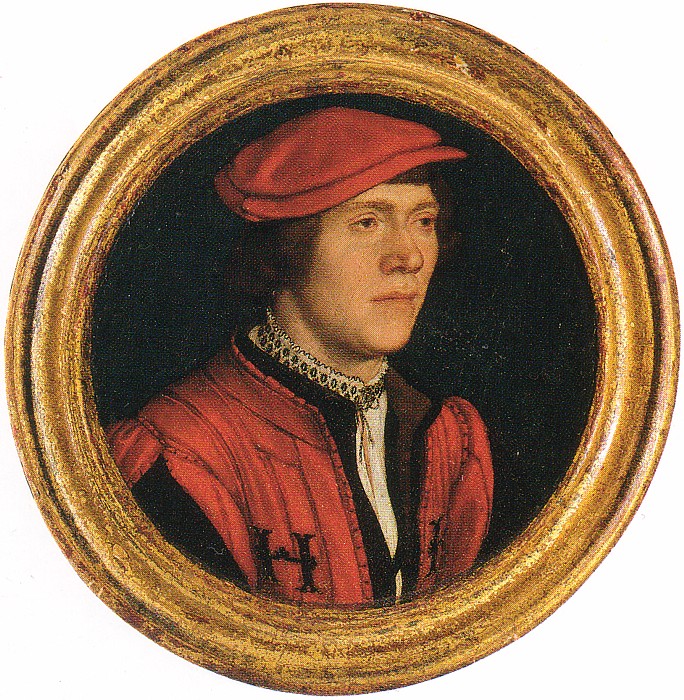
Hans Holbein, Unknown man (Vienna)
Holbein would have worn the same livery with the letters HR on the front and a Tudor rose on the back, and made out of fine material such as velvet. When he returned to Basel he was criticised for wearing such fine clothes. His self-portrait may have been painted by Horenbout, according to Susan Foster.
We have verses from Henry’s court praising Holbein as the new Apelles.
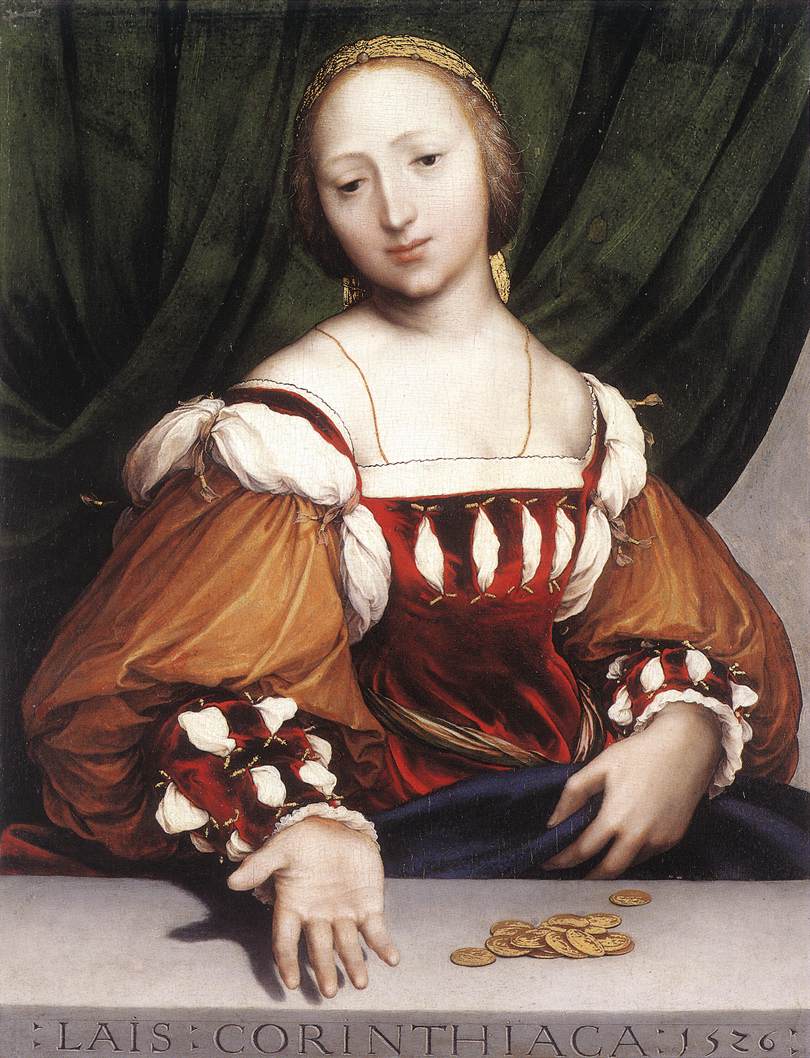
Hans Holbein, La’s Corinth (Basle), 1526
This painting could be a reference to Apelles as La s of Corinth was his lover and courtesan and she is said to have only agreed to model for Apelles when she had been paid enough.
Was it good to be a court painter? That depends on the terms of the contract. You would have been exempt from guild restrictions so as a foreign painter it would allow you to work in England. You may have been allowed to take outside commissions as Van Eyck and Holbein were. We don’t know if Holbein did this to make even more money (he was paid 30 a year) or to simply make ends meet. We know he died with only 17s 6d to his name but we don’t know why he had so little. He had a wife and children in Basel to support although the city of Basel paid for their support, and he had a mistress in London.
How could an artist raise his status? By getting educated, reading, writing, reading the classics, making classical allusions, by being up-to-date with the latest techniques, mix in humanist circles (like Durer and Holbein), use Latin inscriptions and work for high status patrons.
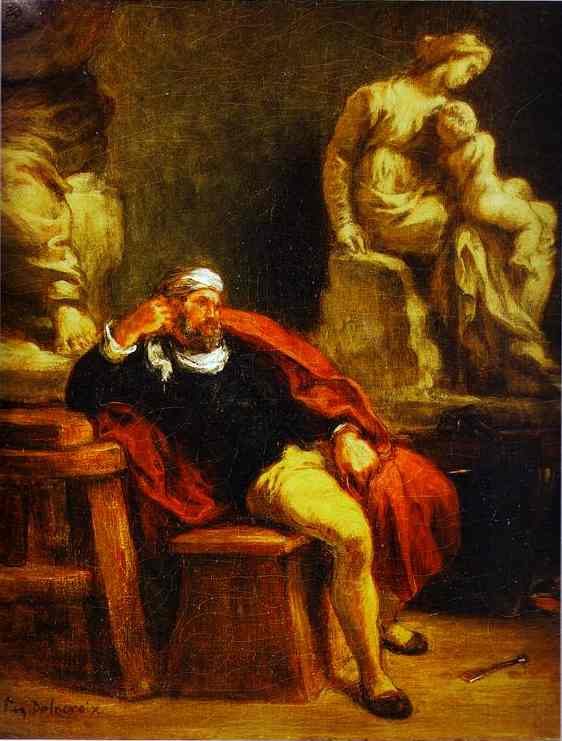
Eugene Delacroix, Michelangelo in his Studio (Montpelier), 1850
We have inherited certain associations about the genius artist that are shown in this painting by Delacroix. The melancholic pose, oriental turban, the work in the background looks back to classical style showing his education, he is not working, in fact his chisel looks as though it has been thrown to the floor maybe in a fit of artistic pique. We see the Romantic artist who works through his in-born self-expression of genius. None of this, of course, applies to Tudor England.
Nicholas Hilliard, A Treatise concerning the arte of limning (manuscript, c.1598-1602/3) printed in R. Thornton & T. Cain (ed.s), A Treatise Concerning the Art of Limning by Nicholas Hilliard (Manchester, 1981), p.63:
The ancient Romans in time past forbade that any should be taught the art of painting, save gentlemen only. I conjecture they did it upon judgement of this ground: as thinking that no man using the same to get his living by, if he was a needy artificer, could have the patience or leisure to perform any exact, true and rare piece of work; but men ingeniously born, and of sufficient means, not subject to those common cares of the world for food and garment, moved with emulation and desire therof, would do their uttermost best, not respecting the profit or the length of time; nor permit any unworthy work to be published under their name to common view, but deface it again rather, and never leave till some excellent piece of art were by him or them performed worthy of some commendations. By reason whereof it was no wonder that the most excellent nation and wits of the world thee brought forth the most rare works in painting that ever were; it must needs be granted then for ever. And like as one good workman then made another, so one botcher nowadays maketh many, and they increase so fast that good workmen give over to use their best skill, for all men carry one price.
Now, therefore, I wish it were so that none should meddle with limning but gentlemen alone, for that it is a kind of gentle painting, of less subjection than any other; for one may leave when he will his colours nor his work taketh any harm by it. Moreover, it is a secret: a man may use it, and scarcely be perceived of his own folk. It is sweet and cleanly to use, and it is a thing apart from all other painting or drawing, and tendeth not to common men’s use, either for furnishing of houses, or any patterns for tapestries, or building, or any other work whatsoever.
Note the classical references, associating artists with gentlemen and as people who did not need to work. His solution if fact is not that painting should have a higher status but only his particular narrow specialisation of limning.
This is extraordinary when we consider that in Italy Titian had been made a noble and Michelangelo had had the equivalent of a state funeral.
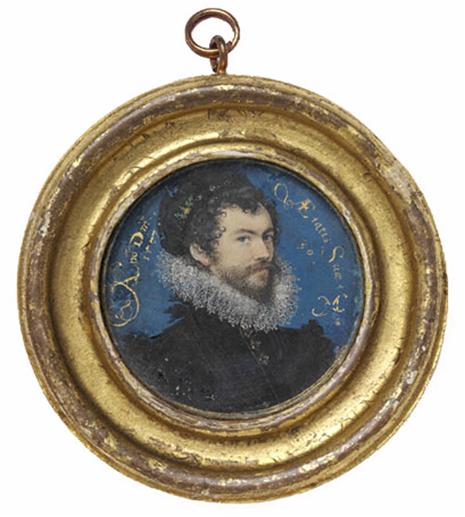
Nicholas Hilliard, Self-portrait (V&A), 1577
If we look at Hilliard’s self-portrait and compare it with the portrait of a gentleman below we see he is presenting himself as a gentleman. There is no sign of the tools of the trade.
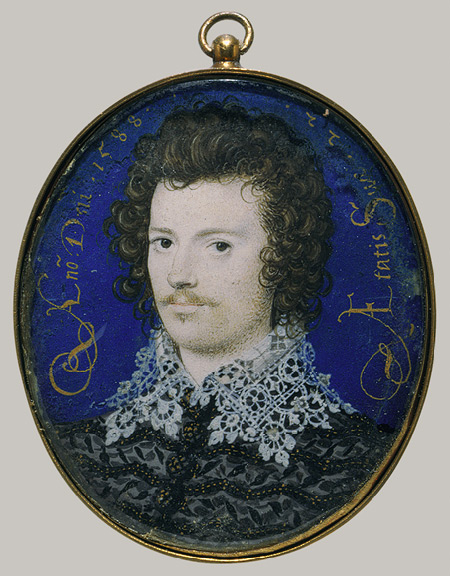
Nicholas Hilliard, Unknown gentleman (Fitzwilliam Museum), 1574
His wife’s portrait below also shows her as a fine lady.
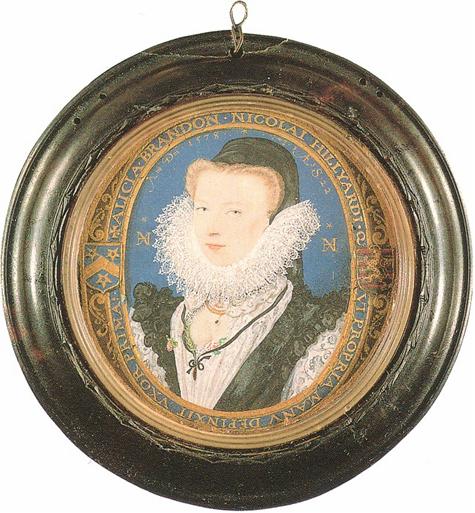
Nicholas Hilliard, Alice Brandon, Hilliard’s Wife (V&A), 1578
Compare this with Holbein’s portrait of his wife and children below. Remeber the first quote where Hilliard said “under a savage government wherein arts be not esteemed”. He was clearly bitter about his lowly status.
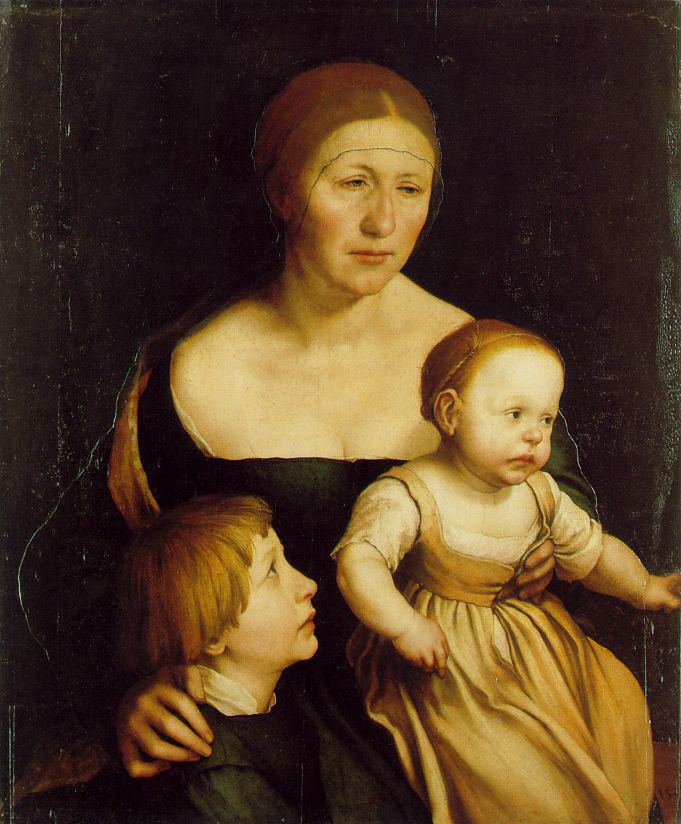
Hans Holbein, Portrait of the Painter’s Wife and Children (Basle), c. 1520s
There is no comparison, we move from a fanciful statement of petty status to an honest and timeless representation of a human being.
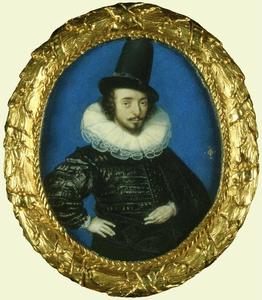
Isaac Oliver, Self-portrait (Royal Collection), c. 1590s
If we look at two of Oliver’s portraits we see the same representation of himself as a gentleman with no indication of his trade.
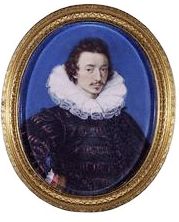
Isaac Oliver, Self-portrait (NPG), c. 1590s
Towards the end of the sixteenth century that status of painters was starting to change as will be made clear later. However, the Buck quote above was from the 1615 edition of the encyclopaedia so attitudes only changed very slowly.

